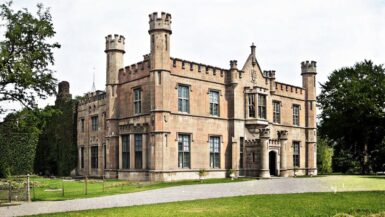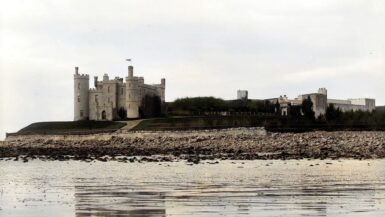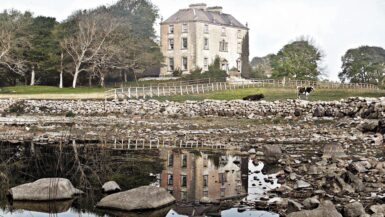Nestled on the northern coast of the Fanad Peninsula in County Donegal, Ireland, Fanad Lighthouse stands as a beacon of maritime history and architectural beauty. Overlooking the wild Atlantic Ocean, this iconic lighthouse serves not only as a critical navigation aid but also as a cherished historical monument. First lit on March 17, 1817, Fanad Lighthouse was constructed in response to the tragic wrecking of the HMS Saldanha in 1811, underscoring its foundational role in enhancing maritime safety. Today, the lighthouse is celebrated not only for its striking presence against the rugged Irish coastline but also as a prime tourist destination. It offers visitors a unique glimpse into the life of a lighthouse keeper through its beautifully restored keeper’s cottages, now converted into self-catering accommodations. As one of the signature discovery points on the Wild Atlantic Way, Fanad Lighthouse enriches the cultural fabric of the region, drawing visitors from around the globe to experience its majestic setting and rich historical tapestry.
Contents
Historical Background
The story of Fanad Lighthouse is deeply entwined with maritime safety and architectural achievement. This section explores the catalytic events leading to its creation, the people involved in its design and construction, and the subsequent modifications that have preserved its functionality and historical integrity over the centuries.
The HMS Saldanha Tragedy
The impetus for building Fanad Lighthouse was the tragic loss of the HMS Saldanha. On the stormy night of December 4, 1811, this Royal Navy warship was navigating the waters near Fanad Head when it struck rocks and sank in the violent seas. Along with over 250 souls aboard, the ship’s young captain, William Pakenham, perished, leaving no human survivors; remarkably, only the ship’s parrot was found alive. This maritime disaster highlighted the perilous nature of the North Atlantic waters and the urgent need for a navigational aid at this treacherous point on the Irish coast.
Construction of the Lighthouse
Responding to the dire need signaled by the Saldanha wreck, a proposal for a lighthouse at Fanad Head was quickly set in motion. George Halpin, a renowned civil engineer known for his extensive work on Irish lighthouses, was commissioned to design the new beacon. Halpin was an Inspector of Lighthouses at the time and had a prolific career that would ultimately include the design and supervision of over fifty lighthouses around Ireland.
The construction of Fanad Lighthouse began in 1815, with its completion and first lighting occurring on Saint Patrick’s Day, 1817. The original structure utilized sperm oil wick lamps and featured parabolic reflectors to maximize the light’s visibility. These lamps showed different colors—red towards the Atlantic Ocean and white towards Lough Swilly—signaling a sophisticated design for its time.

Enhancements and Reconstruction
As shipping traffic increased and maritime technology evolved, so too did the requirements for more effective lighthouses. By the 1870s, it became clear that the Fanad Lighthouse needed enhancements to improve its visibility and functionality. This led to the 1886 reconstruction, which involved building a taller tower to elevate the light’s reach and visibility from the Atlantic side. This project not only extended the lighthouse’s range but also incorporated more modern lighting technology.
The newer structure was again the work of prominent engineers of the era, ensuring that the lighthouse not only met but exceeded the maritime safety needs of the time. These enhancements have allowed Fanad Lighthouse to continue serving as a vital navigational aid, enduring as a symbol of resilience and guardianship over the perilous North Atlantic waters.
Architectural Features
Fanad Lighthouse is renowned not only for its historical significance and functional utility but also for its distinctive architectural elements. Designed by the eminent engineer George Halpin, its structure combines practicality with aesthetic elegance, making it a standout feature on the rugged coastline of County Donegal.
Design and Dimensions
The lighthouse tower, cylindrical in shape, stands 22 meters high from its foundation to the top of the tower, excluding the lantern room. The light itself is positioned 39 meters above sea level, ensuring its beam is visible far across the Atlantic. To reach the lantern room, keepers would climb a total of 76 steps: 59 of these are spiral granite steps winding tightly within the tower, followed by an additional 17 ladder steps that lead directly into the lantern room.
Architectural Style
The lighthouse’s design reflects the typical 19th-century Irish lighthouse construction, characterized by its robust, utilitarian structure designed to withstand the harsh Atlantic weather. The exterior is constructed from locally sourced granite, giving it a sturdy yet refined appearance. This material not only offers durability against the elements but also adds a timeless beauty to the lighthouse, allowing it to blend seamlessly with the natural surroundings.
Unique Features
One of the most striking features of Fanad Lighthouse is its diamond-shaped windows. These are not merely decorative; they are strategically designed to withstand high winds while providing natural light to the interior. Additionally, the lighthouse boasts a beautifully crafted spiral staircase that serves as the backbone of the structure, providing access to the lantern room. This staircase is not only functional but also a piece of art, showcasing the craftsmanship of the era.
The interior of the lighthouse, particularly in the lantern room, is equally impressive. The original setup included parabolic reflectors and sperm oil wick lamps, a state-of-the-art technology at the time of construction, which has been updated over the years to keep pace with advancements in lighthouse technology.

Operations and Modernizations
Over the years, Fanad Lighthouse has undergone several operational upgrades and modernizations to meet the evolving needs of maritime navigation and safety. These improvements reflect the technological advancements in lighthouse engineering and the commitment to maintaining the lighthouse’s effectiveness as a critical navigational aid.
Transition to Electricity and Automation
Originally, Fanad Lighthouse was equipped with sperm oil wick lamps and parabolic reflectors, a common lighting method in the early 19th century. These lamps emitted a steady, reliable light but required constant maintenance and manual operation by the lighthouse keepers. As technology advanced, the lighthouse underwent significant modernization.
The first major upgrade occurred in the early 20th century when the lighthouse transitioned from oil lamps to electric lighting. This shift significantly improved the intensity and reliability of the light, allowing it to be seen from greater distances and reducing the workload for the lighthouse keepers. Electric lights also meant fewer emissions and a cleaner working environment.
The most transformative change came in 1975 when Fanad Lighthouse was fully automated. Automation meant that the lighthouse no longer required constant human presence to operate effectively. Sensors and automated systems were installed to control the light, making it self-sufficient and significantly reducing operational costs. This automation led to the eventual departure of the last lighthouse keeper in 1983, marking the end of an era for Fanad Lighthouse.
Installation of the Helipad
Another significant modernization at Fanad Lighthouse was the construction of a helipad in 1969. This addition was primarily intended to facilitate the transport of personnel and supplies to and from the lighthouse, particularly for those located on more remote islands like Tory and Inishtrahull. The helipad allowed for quicker response times in emergencies and made routine maintenance visits more efficient, reducing the reliance on boat transportation which could be hindered by the often treacherous Atlantic seas.
Today, the helipad is seldom used, but it remains a vital resource for emergency services. It is occasionally utilized by the Coast Guard or Army helicopters during search and rescue operations or other emergencies.
Life at the Lighthouse
Living at Fanad Lighthouse was not only a professional commitment for the keepers and their families but also a unique, isolated, and sometimes challenging way of life. The daily routines, responsibilities, and educational experiences of those residing at the lighthouse paint a vivid picture of a close-knit community bound by duty and the rhythms of the sea.
Daily Life of Lighthouse Keepers and Their Families
Life for the lighthouse keepers at Fanad was marked by strict routines necessary for the maintenance and operation of the lighthouse. Each day was structured around the imperative to ensure that the light was operational from sunset to sunrise, which involved regular maintenance checks, cleaning the light mechanism, and refueling, initially with sperm oil.
Lighthouse keepers were also responsible for weather observations and reporting any maritime distress signals or emergencies they observed, which were crucial for the safety of passing vessels. The isolation and responsibility borne by the keepers required a person of strong character and resilience.
Their families shared this isolated existence, creating a small, tightly-knit community. Keepers’ families often lived in the adjacent cottages, and their lives were deeply intertwined with the rhythms of the lighthouse and the sea. Despite the remote location, family life thrived, with the lighthouse grounds providing a unique, albeit constrained, playground for children.
Educational Aspects for Children
Children living at Fanad Lighthouse faced unique educational circumstances. They attended Ballymichael School, which was about a 1.5-mile walk from the lighthouse, often uphill. This school was a Gaeltacht school, meaning that instruction was primarily in Irish, offering children from the lighthouse an immersive experience in the local language and culture. This environment not only facilitated language learning but also helped integrate the children into the broader community.
Attending a Gaeltacht school had a significant impact on the children’s education, providing them with the opportunity to become fluent in Irish and gain a deeper understanding of Irish cultural traditions. The daily walk to and from school also instilled a sense of independence and resilience, qualities necessary for life in such a remote location.
For the children, this unique upbringing had both its challenges and rewards. While they might have felt isolated from children in more urban areas, the natural environment provided a remarkable backdrop to their childhood, filled with adventure and exploration. Furthermore, the small school size often meant more direct attention from teachers and a close-knit group of school friends.
Cultural and Community Impact
Fanad Lighthouse has played a pivotal role in the local community and broader regional tourism, particularly as a part of the Wild Atlantic Way, a scenic coastal route that showcases Ireland’s rugged and breathtaking Atlantic coastline.
Role Within the Local Community
Historically, Fanad Lighthouse has been more than just a navigational aid; it’s a cultural landmark deeply rooted in the local community. It has provided employment and supported local economies through its operational needs and the families it housed. The lighthouse keepers and their families were integral parts of the local fabric, participating in community activities and contributing to the small local economy.
As a part of the Wild Atlantic Way, Fanad Lighthouse draws attention to this lesser-explored part of Ireland, highlighting the natural beauty and rich history of the Fanad Peninsula. This inclusion has helped elevate the profile of the area, encouraging a deeper appreciation for its cultural heritage and natural landscapes.
Visitor Attraction and Economic Benefits
Today, Fanad Lighthouse is a significant tourist attraction, drawing visitors from around the globe interested in its history, architectural beauty, and the stunning views it offers of the Atlantic Ocean. Its status as a visitor attraction has stimulated local businesses, from accommodations and restaurants to local arts and crafts, boosting the local economy significantly.
The lighthouse’s appeal adds to the cultural richness of the region, providing an educational resource that allows visitors to learn about maritime history, navigation technology, and the lifestyle of lighthouse keepers. This influx of tourists supports cultural preservation and promotes sustainability in the area.
Preservation and Public Engagement
Efforts to preserve Fanad Lighthouse and its history have been ongoing, emphasizing both its architectural integrity and its historical significance.
Preservation Efforts
The lighthouse has been meticulously maintained, with renovations and restorations undertaken to ensure that its historical features are preserved while also accommodating modern safety standards. These efforts ensure that Fanad Lighthouse remains not only a functional navigational aid but also a preserved historical site that reflects its long-standing maritime heritage.
Public Access and Engagement
Fanad Lighthouse is open to the public, offering guided tours that provide insight into the history of the lighthouse and the lives of its keepers. These tours are crucial for public engagement, offering visitors a hands-on experience with historical artifacts and access to the lighthouse’s internal workings, including its original optic.
Additionally, the restored lightkeepers’ cottages have been converted into self-catering accommodations, allowing visitors to experience life at the lighthouse. This unique accommodation option not only enhances the visitor experience but also plays a vital role in the site’s economic sustainability.







Leave a reply